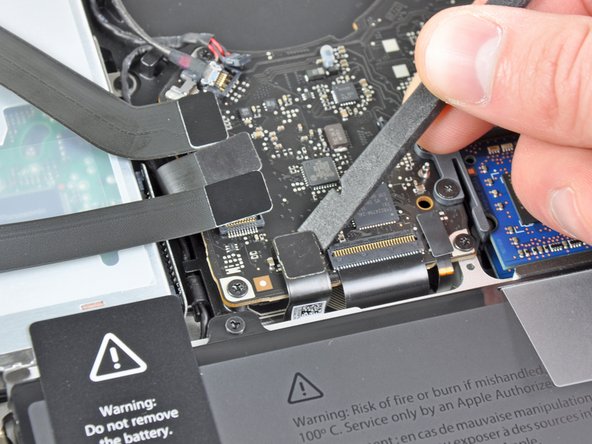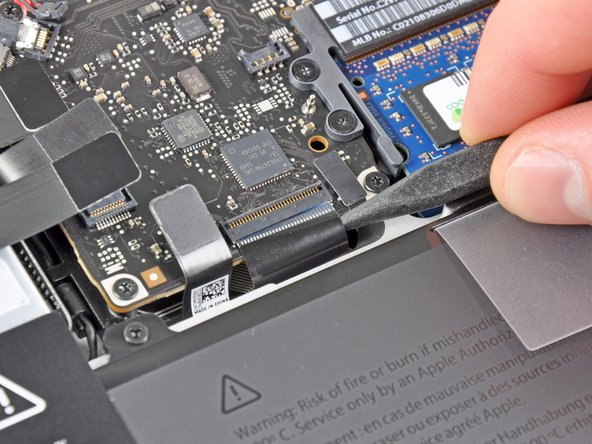Deze versie kan foutieve bewerkingen bevatten. Schakel over naar de recentste gecontroleerde momentopname.
Wat je nodig hebt
-
-
Verwijder de volgende tien schroeven:
-
Drie 14.4 mm lange Phillips #00 schroeven
-
Drie 3.5 mm lange Phillips #00 schroeven
-
Vier 3.5 mm lange geschouderde Phillips #00 schroeven
-
-
-
Gebruik de voor- of achterkant van een spudger om de batterijaansluiting uit het contact op het moederbord omhoog te wrikken.
-
-
Deze stap is niet vertaald. Help het te vertalen
-
Use the edge of a spudger to gently pry the fan connector up and out of its socket on the logic board.
-
-
Deze stap is niet vertaald. Help het te vertalen
-
Remove the following three screws securing the fan to the logic board:
-
One 7.2 mm T6 Torx screw
-
Two 5.3 mm T6 Torx screws
-
-
Deze stap is niet vertaald. Help het te vertalen
-
Lift the fan out of its recess in the logic board, minding its cable that may get caught.
-
-
-
Deze stap is niet vertaald. Help het te vertalen
-
Use the tip of a spudger to pull the right speaker/subwoofer cable out from under the retaining finger molded into the upper case.
-
Pull the right speaker/subwoofer cable upward to lift the connector out of its socket on the logic board.
-
-
Deze stap is niet vertaald. Help het te vertalen
-
Disconnect the following four cables:
-
AirPort/Bluetooth cable
-
Optical drive cable
-
Hard drive cable
-
Trackpad cable
-
-
Deze stap is niet vertaald. Help het te vertalen
-
Use your fingernail to flip up the retaining flap on the keyboard ribbon cable ZIF socket.
-
Use the tip of a spudger to pull the keyboard ribbon cable out of its socket.
-
-
Deze stap is niet vertaald. Help het te vertalen
-
If present, remove the small strip of black tape covering the keyboard backlight cable socket.
-
-
Deze stap is niet vertaald. Help het te vertalen
-
Use the tip of a spudger or your fingernail to flip up the retaining flap on the keyboard backlight ribbon cable ZIF socket.
-
Pull the keyboard backlight ribbon cable out of its socket.
-
-
Deze stap is niet vertaald. Help het te vertalen
-
Use the flat end of a spudger to pry the sleep sensor/battery indicator connector up from its socket on the logic board.
-
-
Deze stap is niet vertaald. Help het te vertalen
-
Grab the plastic pull tab secured to the display data cable lock and rotate it toward the DC-In side of the computer.
-
Pull the display data cable straight out of its socket on the logic board.
-
-
Deze stap is niet vertaald. Help het te vertalen
-
Remove the following nine screws:
-
Five 3.6 mm T6 Torx screws
-
Two 4.3 mm T6 Torx screws
-
Two 7.2 mm T6 Torx screws
-
Five 3.0 mm T6 screws
-
Two 3.6 mm T6 screws
-
Two 6.7 mm T6 screws
-
-
Deze stap is niet vertaald. Help het te vertalen
-
Remove the following two screws:
-
One 8.6 mm Phillips screw
-
One 5.5 mm Phillips screw
-
Remove the display data cable retainer from the upper case.
-
-
Deze stap is niet vertaald. Help het te vertalen
-
Use the tip of a spudger to gently peel the microphone off the adhesive securing it to the upper case.
-
-
Deze stap is niet vertaald. Help het te vertalen
-
Minding the many connectors near its edges, lift the logic board from the end nearest the optical drive.
-
Without flexing the board, maneuver it out of the upper case, minding the flexible connection to the DC-In board that may get caught in the upper case.
-
Remove the logic board.
-
-
Deze stap is niet vertaald. Help het te vertalen
-
Remove the three 8.4 mm #1 Phillips screws securing the heat sink to the logic board.
-
Annuleren: ik heb deze handleiding niet afgemaakt.
57 andere personen hebben deze handleiding voltooid.
6 opmerkingen
Really nice repair guide! There's no way I would have gotten this right without your help, but after following your guide my computer works like a million bucks. I had gotten so used to the fan running full speed all the time I almost didn't notice it anymore, but with the new heat sink the fan runs a low speed once again and the computer is nice and quiet like it was when it was new. Thank you.
hello sir i have done all the steps but my macbook still heating up
Check the radiator, when I first opened mine up it was filled with dust. The radiator has a pipe coming from the CPU and it is right in front of the fan. It has little lines coming from it. I used a vacuum to clean it.
Thanks for the guide!
I had huge problems with heating up .. I even got a “leg hair burns” :)
I followed this instruction, replaced thermal paste (nothing fancy .. just some “normal” paste from local IT store), cleaned out all the dust (especially from fan)
now its running like new … fan rarely kicks in and when it does it cools it down really quickly. Of course running some intense apps (like lightroom, starting up photos app, many open chrome tabs with youtube etc … ) will do a lot of stress on CPU so it will heat up.
In general some slight “heating up” is always there .. Apple prefers to run their laptops warmer than spinning up fans. But after proper cleaning and replacing thermal paste it is much more manageable.
Small tip: those really small ribbon cables can be a pain in the a** to put back in, so i got them close to the connector, put a little sticky tape on them and used that sticky tape to pull on the cable and push it in the slot.
Like show in the last picture (21) on the left upper side there is a square shaped black plastic cover. Should we put the thermal paste there also ? Or we should not touch it? Thanks!


































